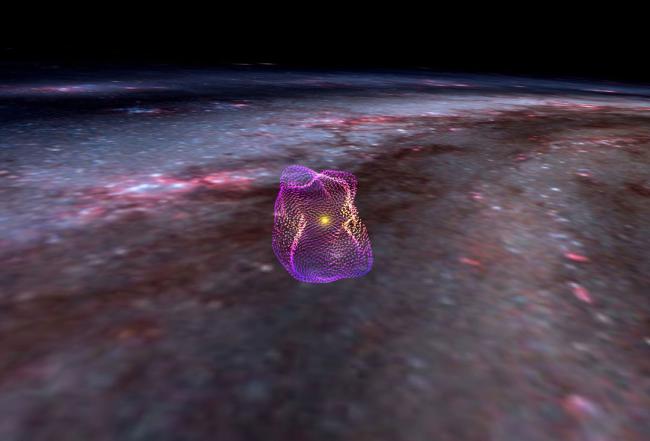Astronomers have mapped the magnetic field along the “bubble” of gas 1,000 light-years wide around the Sun.

Theo O'Neill / World Wide Telescope
Long ago, supernovae blew out a gigantic bubble, sweeping up interstellar gas into what is now a 1,000 light-year-wide shell. The Sun, purely by chance, sits near its center. A new map of the magnetic field along this shell may help astronomers understand the origin of this Local Bubble as well as the role of such structures in galaxy evolution.
Last year, Catherine Zucker (Center of Astrophysics, Harvard & Smithsonian) announced at the 240th meeting of the American Astronomical Society (AAS) that she and colleagues had mapped the dust of the Local Bubble by measuring its dimming effect on more distant stars. The bubble, she found, had pushed out gas, triggering starbirth in nurseries all around the Sun.
One year later, at the AAS's 241st meeting in Seattle, Theo O'Neill (University of Virginia) reported work done with members of the same team to add magnetic field information to that map. O'Neill used the European Space Agency's Planck satellite to look at polarized light, in which light waves became aligned after scattering off intervening dust. By assuming that the dust lies in the Sun's vicinity rather than farther away in our galaxy or beyond, O'Neill was able to transform the polarization of light into magnetic field strength and direction.
The result is a magnetic map of the Local Bubble; you can interact with a 3D version here. The study itself is available on Authorea but has not yet undergone peer review.
Mapping the magnetic field is only the first step for further understanding the Local Bubble and others like it across the galaxy. "There have been recent results finding hundreds to thousands of bubbles in single galaxies," O'Neill says. "It's likely that our own Milky Way is similar."
While bubbles are probably ubiquitous in the Milky Way, it's harder to see detail in the ones beyond the local one that surrounds us. Yet they impact the galaxy's evolution in subtle ways. The sweeping-out of gas deprives the central regions of star-forming fuel while at the same time triggering starbirth along the shell. Bubbles may thus regulate the rate at which stars are born, shape the magnetic field that permeates the galactic disk, and even collide with one another.
Ultimately, the magnetic map can also help us understand how the Local Bubble came to be. "There may be insights from this present-day map, and extrapolating back into time," O'Neill says, adding that that extrapolation could be extended as far back as the chain of supernovae that blew out the Local Bubble in the first place.
 5
5
Comments
Howard
January 13, 2023 at 7:56 pm
Could this new magnetized/plasma boundary surrounding the Solar System affect the interpretation of the CMB anisotropies in that it may cause some refraction and polarization of the radition not included in the background removed from Planck?
You must be logged in to post a comment.
Cedardoc
January 15, 2023 at 3:17 pm
"The Sun, purely by chance, sits near its center. "
Why "purely by chance"?
You must be logged in to post a comment.
Monica YoungPost Author
January 17, 2023 at 10:16 am
Yeah, I didn't believe that at first either! But if you look at the Sun's motion versus the Local Bubble, our system only entered it a million years ago iirc, but the Bubble was around many millions of years before then. The fact that we lie near (not exactly at) the center by chance indicates that these kinds of bubbles are common in our galaxy. Observations of other galaxies bear this out, with hundreds or thousands of bubbles observed in each galaxy. (JWST is particularly good at finding these bubbles!)
You must be logged in to post a comment.
jackkessler
January 18, 2023 at 4:10 pm
Are there any effects on earth from being in the bubble?
You must be logged in to post a comment.
Monica YoungPost Author
January 20, 2023 at 9:42 am
Good question! Most of the action of the bubble occurs at its edges, because it's essentially a shock wave that's sweeping out gas. That's why the newer stars near the Sun nearly all form on or near the bubble's edge.
You must be logged in to post a comment.
You must be logged in to post a comment.